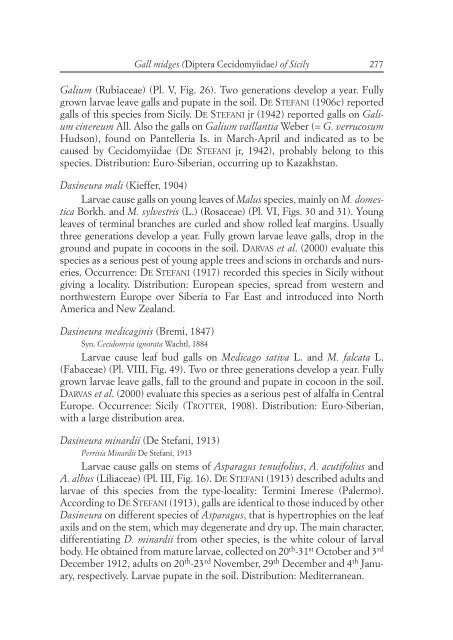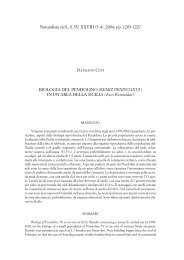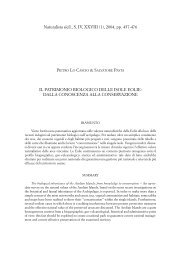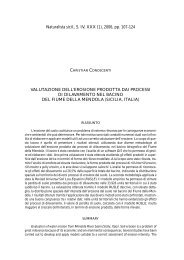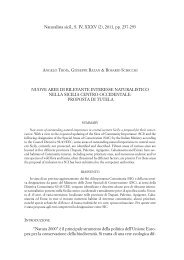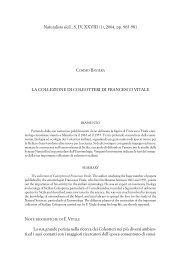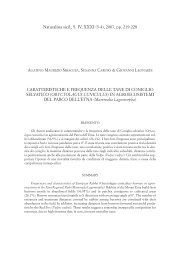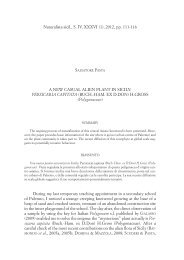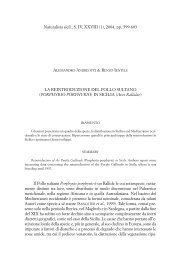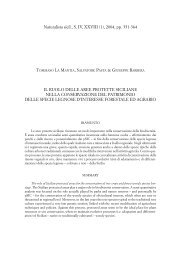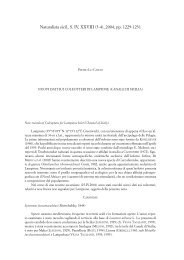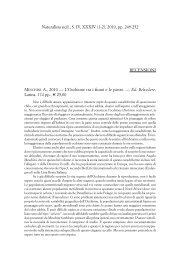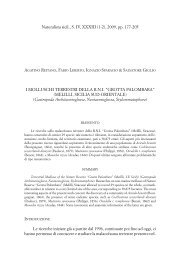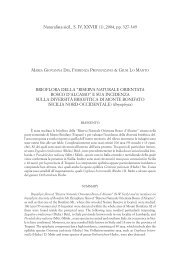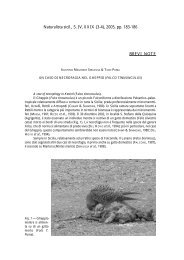2007,pp - Società Siciliana di Scienze Naturali
2007,pp - Società Siciliana di Scienze Naturali
2007,pp - Società Siciliana di Scienze Naturali
Create successful ePaper yourself
Turn your PDF publications into a flip-book with our unique Google optimized e-Paper software.
Gall midges (Diptera Cecidomyiidae) of Sicily<br />
277<br />
Galium (Rubiaceae) (Pl. V, Fig. 26). Two generations develop a year. Fully<br />
grown larvae leave galls and pupate in the soil. DE STEFANI (1906c) reported<br />
galls of this species from Sicily. DE STEFANI jr (1942) reported galls on Galium<br />
cinereum All. Also the galls on Galium vaillantia Weber (= G. verrucosum<br />
Hudson), found on Pantelleria Is. in March-April and in<strong>di</strong>cated as to be<br />
caused by Cecidomyiidae (DE STEFANI jr, 1942), probably belong to this<br />
species. Distribution: Euro-Siberian, occurring up to Kazakhstan.<br />
Dasineura mali (Kieffer, 1904)<br />
Larvae cause galls on young leaves of Malus species, mainly on M. domestica<br />
Borkh. and M. sylvestris (L.) (Rosaceae) (Pl. VI, Figs. 30 and 31). Young<br />
leaves of terminal branches are curled and show rolled leaf margins. Usually<br />
three generations develop a year. Fully grown larvae leave galls, drop in the<br />
ground and pupate in cocoons in the soil. DARVAS et al. (2000) evaluate this<br />
species as a serious pest of young a<strong>pp</strong>le trees and scions in orchards and nurseries.<br />
Occurrence: DE STEFANI (1917) recorded this species in Sicily without<br />
giving a locality. Distribution: European species, spread from western and<br />
northwestern Europe over Siberia to Far East and introduced into North<br />
America and New Zealand.<br />
Dasineura me<strong>di</strong>caginis (Bremi, 1847)<br />
Syn. Cecidomyia ignorata Wachtl, 1884<br />
Larvae cause leaf bud galls on Me<strong>di</strong>cago sativa L. and M. falcata L.<br />
(Fabaceae) (Pl. VIII, Fig. 49). Two or three generations develop a year. Fully<br />
grown larvae leave galls, fall to the ground and pupate in cocoon in the soil.<br />
DARVAS et al. (2000) evaluate this species as a serious pest of alfalfa in Central<br />
Europe. Occurrence: Sicily (TROTTER, 1908). Distribution: Euro-Siberian,<br />
with a large <strong>di</strong>stribution area.<br />
Dasineura minar<strong>di</strong>i (De Stefani, 1913)<br />
Perrisia Minar<strong>di</strong>i De Stefani, 1913<br />
Larvae cause galls on stems of Asparagus tenuifolius, A. acutifolius and<br />
A. albus (Liliaceae) (Pl. III, Fig. 16). DE STEFANI (1913) described adults and<br />
larvae of this species from the type-locality: Termini Imerese (Palermo).<br />
Accor<strong>di</strong>ng to DE STEFANI (1913), galls are identical to those induced by other<br />
Dasineura on <strong>di</strong>fferent species of Asparagus, that is hypertrophies on the leaf<br />
axils and on the stem, which may degenerate and dry up. The main character,<br />
<strong>di</strong>fferentiating D. minar<strong>di</strong>i from other species, is the white colour of larval<br />
body. He obtained from mature larvae, collected on 20 th -31 st October and 3 rd<br />
December 1912, adults on 20 th -23 rd November, 29 th December and 4 th January,<br />
respectively. Larvae pupate in the soil. Distribution: Me<strong>di</strong>terranean.


